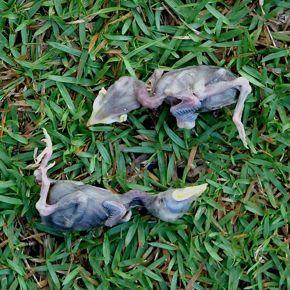In late May, I found a dead chick lying on the ground in my garden (above). Only a few ants were around to feed on the chick. How it got there is a puzzle. It was definitely not pushed out of the nest, as all the trees were some distance away. A predator could have dumped it there. But then the dead chick was intact, no parts missing. So what was the intention of the predator, if not to feed on it?
I have not been able to identify the dead chick. I have images of a two-day old Yellow-vented Bulbul (Pycnonotus goiavier) but it is definitely not a bulbul (below left). I did encounter dead Javan Myna (Acridotheres javanicus) chicks lying around in the garden some time before. This dead chick may be Javan Myna but I am not sure (below right). Any opinions?
The dead chick is blind, meaning that the eyes have yet to open (below). Its entire body is sparsely covered with natal down. These are fluffy, soft, vaneless feathers that lack a feather shaft. Natal down is present only at the time of hatching. Thus this chick is most probable about one or two days old.
Had the chick lived, it will develop its first set of feathers, the juvenal feathers. These feathers will push out the natal down that will often remain attached to their ends for some time. The new feathers are sheathed, appearing as pin feathers, see HERE.
Prominent on both sides of the head and lining the oral cavity are the swollen, light yellow orange flanges. Together with the bright red gape that these flanges surround, they serve as “food targets” for the adults to direct food into LINK. As the chick grows older, these oral flanges disappear.
YC Wee
Singapore
August 2014


![dead chick 1d old? [wyc] - 05](https://besgroup.org/wp-content/uploads/dead-chick-1d-old-wyc-05.jpg)


![dead chick 1d old? [wyc] - 08 - Version 2](https://besgroup.org/wp-content/uploads/dead-chick-1d-old-wyc-08-Version-2.jpg)






